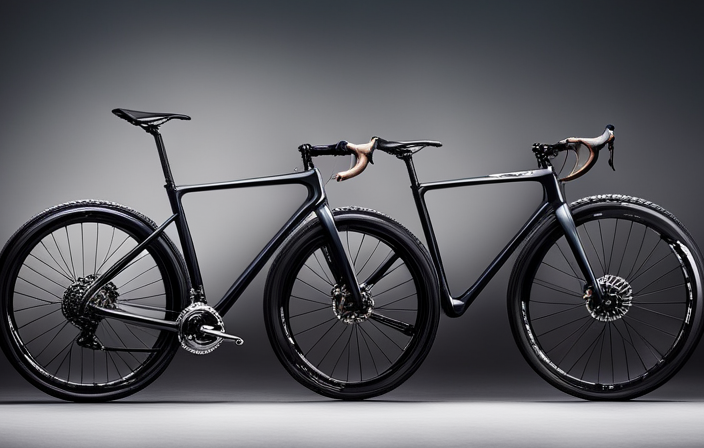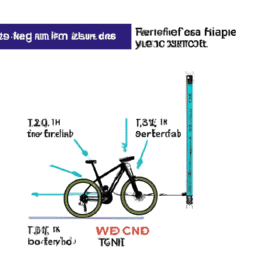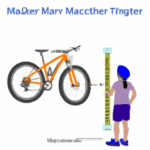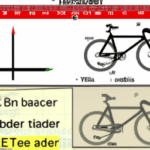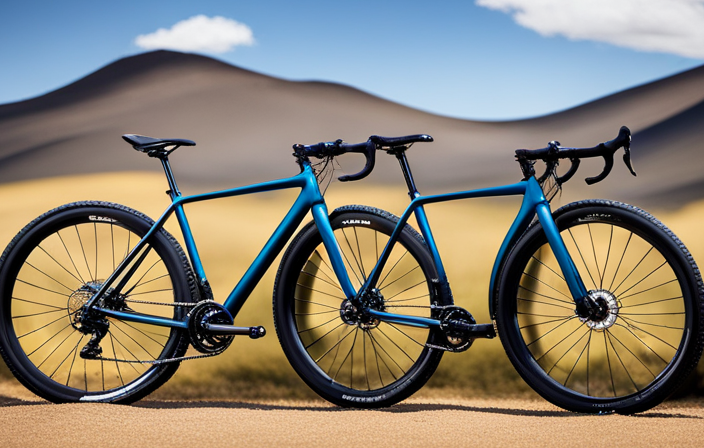Selecting the ideal size for your gravel bike is akin to placing a puzzle piece into an intricate and thrilling journey. Similar to how each rider possesses a distinct style and set of preferences, the perfect bike size for them also differs.
In this article, I will guide you through the technicalities of sizing a gravel bike, helping you measure inseam length, determine frame size, choose handlebar width, and more.
So tighten your helmet straps and let’s embark on the quest for that perfectly sized ride!
Key Takeaways
- Proper bike sizing ensures comfort, efficiency, and performance.
- Factors to consider in bike sizing include riding style and preferences, bike geometry, handlebar shape, saddle comfort, lever placement, and pedal and cleat compatibility.
- Stem length, saddle height, reach and stack measurements, top tube length, and standover height are important measurements to consider in bike sizing.
- Wheel size considerations and test riding different sizes are important in finding the perfect fit for gravel biking adventures.
Understand the Importance of Bike Sizing
Understanding the importance of bike sizing is crucial when it comes to finding the right gravel bike. A properly sized bike ensures comfort, efficiency, and overall performance while riding. Bike fit plays a significant role in preventing discomfort, pain, and even injuries during long rides. One of the most common sizing mistakes is choosing a bike that is too big or too small for your body proportions. Riding a bike that doesn’t match your size can lead to poor handling, decreased power transfer, and reduced control.
To measure your inseam length accurately, start by standing against a wall with your feet shoulder-width apart. Place a book between your legs as if you were sitting on a saddle. Measure from the top of the book to the floor using a tape measure or ruler. This measurement will give you an idea of what frame size might be suitable for you.
Remember that proper gravel bike sizing involves considering other factors like reach and stack measurements as well. Once you have determined your inseam length, consulting with a professional at a local bike shop can help ensure that you choose the correct frame size and make any necessary adjustments for optimal comfort and performance on your gravel adventures.
Measure Your Inseam Length
To determine the appropriate fit for you, start by measuring your inseam length. The importance of bike fit cannot be overstated. A well-fitting bike ensures comfort, efficiency, and enhanced performance. Factors affecting bike sizing include body proportions, flexibility, and riding style.
By measuring your inseam length, you can get a good starting point for finding the right size gravel bike.
To measure your inseam length accurately, stand barefoot against a wall with your feet shoulder-width apart. Place a book or any flat object between your legs, up into your crotch area. Make sure it is parallel to the floor and firmly against the wall. Measure from the top of the book to the floor using a tape measure or ruler.
Once you have obtained this measurement, refer to manufacturer’s sizing charts or consult with a professional bike fitter to find an appropriate frame size that matches your inseam length. Remember that different brands may have slightly different sizing conventions.
Considering your riding style and preferences will also play a crucial role in determining the ideal size for your gravel bike. With this information in hand about measuring your inseam length, let’s move on to considering other factors such as handlebar reach and stack height in order to find the perfect fit for you.
Consider Your Riding Style and Preferences
When considering your riding style and preferences, it’s important to take into account factors such as handlebar reach and stack height. These elements play a crucial role in determining how comfortable and efficient you’ll be on your gravel bike. Riding techniques vary from person to person, so finding the right geometry for your bike is essential.
Here are five key points to consider when evaluating your riding style and preferences:
- Handlebar Reach: This refers to the distance between the saddle and the handlebars. A shorter reach encourages a more upright position, ideal for long rides or riders who prefer a relaxed posture.
- Stack Height: This measures the vertical distance between the bottom bracket and the top of the head tube. A higher stack height provides a more upright riding position, suitable for gravel riders seeking greater stability.
- Bike Geometry: Different frame geometries offer varying levels of responsiveness and stability. Consider whether you prioritize agility or comfort when choosing your gravel bike.
- Suspension Preferences: Some gravel bikes come with front suspension forks or seatpost suspensions that absorb shocks from rough terrain. Evaluate if these features align with your preferred riding style.
- Tire Clearance: Determine whether you want wider tires for better traction or narrower tires for increased speed on smoother surfaces.
By taking into account these aspects of your riding style and preferences, you can better determine which frame size will suit you best.
Transitioning into determining frame size…
Determine Your Frame Size
To determine your ideal frame size, it’s important to consider factors such as your height, inseam measurement, and the manufacturer’s sizing chart. These elements will help you find a gravel bike that fits you properly and provides a comfortable riding experience.
Firstly, take note of your height as it plays a significant role in selecting the right frame size. Manufacturers usually provide guidelines based on height ranges, so be sure to consult their sizing charts for accurate measurements. Additionally, knowing your inseam measurement is crucial because it determines the distance between your crotch and the ground when standing with feet flat.
Next, consider different frame geometries available in the market. Gravel bikes come in various materials like aluminum, steel, or carbon fiber. Each material has its own characteristics regarding weight, stiffness, and comfort. Choose one that suits both your preferences and budget.
Furthermore, pay attention to different frame geometries such as traditional or compact designs. Traditional frames have horizontal top tubes while compact frames feature sloping top tubes for increased standover clearance. Determine which geometry aligns better with your body proportions and riding style.
Now that we’ve covered how to determine your frame size including considering different materials and geometries, let’s move on to choosing the right handlebar width for optimal control and comfort during gravel rides.
Choose the Right Handlebar Width
Choosing the right handlebar width is essential for achieving optimal control and comfort during your gravel rides. The handlebar shape and material play a crucial role in determining the overall feel of your bike.
Here are three key factors to consider when choosing the right handlebar width:
-
Handlebar shape: Different handlebar shapes offer varying degrees of control and comfort. A wider handlebar provides better stability, especially on rough terrain, while a narrower one offers more aerodynamic advantages. Consider your riding style and preferences when deciding on the shape that suits you best.
-
Handlebar material: The material used in constructing the handlebars can affect their weight, durability, and vibration dampening properties. Aluminum handlebars are commonly found on entry-level bikes due to their affordability and decent performance. Carbon fiber bars, on the other hand, are lighter and provide superior shock absorption but come at a higher cost.
-
Ergonomics: Ensure that the chosen handlebar width matches your shoulder width to maintain proper alignment and prevent strain or discomfort. It is crucial to strike a balance between control and comfort by selecting a width that allows for easy maneuvering while providing ample support.
Selecting the appropriate stem length will further enhance your gravel biking experience without compromising safety or performance.
Select the Appropriate Stem Length
Picking the right stem length can greatly enhance your experience while riding on gravel. The stem is an essential component that connects the handlebars to the steerer tube of the bike’s fork. It not only affects your comfort but also influences your bike’s handling and overall performance.
When choosing a stem length, it’s important to consider your body proportions and riding style. Stem lengths vary between bikes, so finding the appropriate one for a gravel bike is crucial. A shorter stem provides quicker steering response and a more nimble feel, making it ideal for technical terrain. On the other hand, a longer stem offers stability at higher speeds and better leverage when climbing out of the saddle.
In addition to length, you should also consider different stem angle options. Most stems have either zero or negative angles, which allow for various handlebar heights and positions. Experimenting with different angles can help you find the most comfortable setup for your riding preferences.
When it comes to materials, carbon fiber stems are popular due to their lightweight construction and vibration-damping properties. However, aluminum stems remain a reliable choice as they offer durability at a lower cost.
With the right stem length and angle options in place, you’ll be ready to find the correct saddle height for optimal comfort during those long gravel rides ahead.
Find the Correct Saddle Height
Finding the correct saddle height is essential for a comfortable and enjoyable ride on rough terrain. It not only affects your pedaling efficiency but also has a significant impact on your overall comfort and power transfer. To ensure you find the right saddle position, here are three key factors to consider:
-
Leg Extension: When seated on the bike with your heel placed on the pedal at its furthest point from you, there should be a slight bend in your knee. This ensures that when you pedal with the ball of your foot, your leg will have the optimal range of motion.
-
Hip Stability: Your hips should remain stable and level while pedaling, without rocking side to side or experiencing any discomfort. Adjusting the saddle height can help achieve this stability.
-
Comfort vs Power: Finding a balance between comfort and power is crucial. A slightly higher saddle position may enhance power transfer but could lead to discomfort or strain over long rides, while a lower position may prioritize comfort but compromise efficiency.
Understanding the importance of saddle tilt is also vital. A neutral tilt allows for proper weight distribution between your sit bones, reducing pressure points and ensuring better blood flow.
Considering these factors will help you find the correct saddle height and tilt for optimal performance and comfort. Now let’s move on to considering reach and stack measurements in order to further optimize your gravel bike setup.
Consider the Reach and Stack Measurements
Adjusting the reach and stack measurements on your bike can help optimize your riding position for better comfort and control.
Reach refers to the horizontal distance between the bottom bracket and the top of the head tube, while stack measures the vertical distance between these two points. These measurements are crucial in determining how well your body fits on the bike. Frame geometry plays a significant role in finding the right reach and stack measurements as different bikes have varying dimensions.
Finding an appropriate reach measurement ensures that you don’t feel too stretched or cramped when cycling. A longer reach may provide a more aerodynamic position, suitable for faster rides, but it could lead to discomfort during long distances. On the other hand, a shorter reach offers more upright positioning, enhancing stability and reducing strain on your back.
The stack measurement influences how high or low you sit on the bike. A higher stack provides a more relaxed riding posture with less stress on your neck and lower back. Conversely, a lower stack promotes an aggressive stance, which is ideal for speed-oriented riding styles.
Considering both reach and stack measurements allows you to fine-tune your gravel bike’s fit according to your preferences and intended use.
Now let’s look at another important aspect: analyzing the top tube length…
Look at the Top Tube Length
Analyzing the top tube length is essential for achieving a comfortable riding position on a gravel bike. It plays a crucial role in determining the overall fit and feel of the bike. Here are four key points to consider when looking at the top tube length:
-
Bike fit: The top tube length directly affects how stretched out or upright you will be on the bike. A longer top tube will result in a more aggressive, aerodynamic position, while a shorter one will provide a more relaxed and upright posture.
-
Gravel bike geometry: Different gravel bikes have varying geometries, and their top tubes can differ significantly. Some bikes may have shorter top tubes to enhance maneuverability and control on technical terrain, while others may prioritize stability with longer top tubes.
-
Riding style: Your preferred riding style should also influence your choice of top tube length. If you enjoy long endurance rides where comfort is paramount, a slightly shorter top tube may be more suitable. On the other hand, if you’re an aggressive rider who loves tackling challenging trails, a longer top tube can provide better stability and handling.
-
Personal preference: Ultimately, personal preference should guide your decision-making process when it comes to choosing the right top tube length for your gravel bike. Keep in mind that what works for one person might not work for another, so it’s important to test ride different bikes and sizes to find your ideal fit.
When considering sizing options for your gravel bike, it’s also important to take into account the standover height as it further contributes to overall comfort and fit without compromising maneuverability or control.
Take into Account the Standover Height
Consider taking into account the standover height when choosing a gravel bike to ensure a comfortable and well-fitting riding experience. Standover height refers to the clearance between the top tube of the bike frame and your inseam when standing over the bike with both feet flat on the ground. It is an important factor in determining if a bike is the right size for you.
To help you understand how standover height impacts your riding experience, consider the following table:
| Frame Size | Rider Height Range |
|---|---|
| Small | 5’2" – 5’6" (157-168cm) |
| Medium | 5’6" – 5’10" (168-178cm) |
| Large | 5’10" – 6’2" (178-188cm) |
| Extra Large | 6’2" – above (188cm-above) |
By choosing a gravel bike with an appropriate standover height, you can enjoy several benefits. Firstly, it ensures that you can easily straddle the bike without any discomfort or restriction. This allows for quick dismounts and greater control in challenging terrain. Secondly, having sufficient clearance prevents accidental contact between yourself and the top tube during sudden stops or emergency maneuvers, reducing the risk of injury.
When considering wheel size in relation to standover height, it’s essential to find a balance that complements each other’s characteristics. [Transition sentence: Now let’s discuss how to consider wheel size when choosing your gravel bike.]
Consider the Wheel Size
Take a moment to think about the wheel size that would best suit your riding style and preferences. When it comes to gravel bikes, selecting the right wheel size is crucial for achieving optimal performance and comfort.
The most common wheel sizes for gravel bikes are 700c and 650b.
The choice between these two sizes depends on several factors, including tire clearance and the type of terrain you plan to ride on. Gravel bikes with 700c wheels offer faster rolling speeds and better efficiency on smooth surfaces. They also provide more tire options due to their larger diameter.
On the other hand, 650b wheels offer increased traction, stability, and comfort on rougher terrains. They allow for wider tires with more volume, which can absorb shocks and vibrations.
Consider your priorities when deciding between wheel sizes – if speed is your main concern, go for 700c wheels; if you prioritize comfort and off-road capability, opt for 650b wheels. Additionally, ensure that the bike frame has adequate tire clearance for your chosen wheel size.
With the knowledge of wheel size selection in mind, let’s move on to the next step: test ride different sizes to find the perfect fit for your gravel biking adventures.
Test Ride Different Sizes
To find the perfect fit for your gravel biking adventures, it’s important to hop on and test ride different wheel sizes. This will allow you to experience firsthand how each size affects the bike’s performance and your overall comfort. When you test ride different sizes, pay close attention to two key factors: test ride comfort and test ride handling.
Test Ride Comfort:
- Focus on how the bike feels under you as you ride over various terrains.
- Pay attention to any discomfort or pressure points that may arise during the test ride.
Test Ride Handling:
- Evaluate how the bike responds to your inputs, such as steering and cornering.
- Observe if there is any wobbling or instability at higher speeds.
By comparing different wheel sizes and assessing these factors, you can determine which size provides optimal comfort and handling for your riding style.
Once you have gathered this valuable information, it’s time to consult with a professional bike fitter who can further fine-tune your gravel bike setup to ensure an ideal fit for your body mechanics.
Consult with a Professional Bike Fitter
It’s essential to consult with a professional bike fitter to optimize your riding experience. A professional bike fitting involves analyzing your body measurements, flexibility, and riding style to determine the best size and fit for your gravel bike. By working with a professional, you can ensure that your bike is adjusted correctly to maximize comfort, efficiency, and power transfer.
One of the benefits of proper bike sizing through professional bike fitting is reducing the risk of injury. When your bike is properly sized, it helps to alleviate stress on your joints and muscles, promoting a more natural and efficient pedaling motion. This can prevent common cycling injuries such as knee pain or lower back discomfort.
Another advantage is improved performance. With the right bike fit, you can achieve optimal aerodynamics and power output. This means that you will be able to ride faster and longer without experiencing unnecessary fatigue or discomfort.
A professional bike fitting also takes into account individual preferences and goals. Whether you’re aiming for long-distance endurance rides or off-road adventures, a customized fit will enhance your overall riding experience by ensuring that your gravel bike matches your specific needs.
By consulting with a professional bike fitter, you can enjoy all these benefits of proper bike sizing. Once you have found the correct size for your gravel bike through this process, adjustments and fine-tuning can be made to further personalize the setup for an even better ride experience.
Adjustments and Fine-Tuning
Make sure you consult with a professional bike fitter to make any necessary adjustments and fine-tune your setup for the best riding experience. When it comes to sizing a gravel bike, there are several fine-tuning techniques that can help optimize your fit on the bike. One common mistake is choosing a frame size solely based on height, which may not take into account individual body proportions. A professional bike fitter will consider factors like inseam length, reach, and stack measurements to determine the appropriate frame size.
Once you have your frame size dialed in, there are additional adjustments that can be made to further tailor your riding position. This includes adjusting the saddle height and fore-aft position to achieve proper knee alignment and optimize power transfer. The handlebar width and stem length can also be adjusted for comfort and control.
To give you an idea of how these adjustments work, here’s a table:
| Adjustment | Purpose |
|---|---|
| Saddle Height | Proper leg extension |
| Saddle Fore-Aft | Optimal knee alignment |
| Handlebar Width | Comfort and control |
| Stem Length | Reach and handling feel |
By making these fine-tuning adjustments, you can ensure that your gravel bike fits you perfectly, allowing for efficient pedaling and enhanced comfort on long rides. Enjoy your perfectly sized gravel bike as you explore new terrains with confidence!
Enjoy Your Perfectly Sized Gravel Bike
Once you have dialed in the adjustments, enjoy the perfect fit of your gravel bike and explore new terrains with confidence. Proper bike sizing is crucial for maximizing performance and comfort on your rides. By using effective bike fit techniques, you can experience a multitude of benefits.
Firstly, proper bike sizing ensures that your body is positioned optimally on the bike. This allows for efficient power transfer from your legs to the pedals, resulting in increased speed and reduced fatigue. Additionally, a well-sized gravel bike promotes better control and stability, especially when navigating uneven or challenging terrains.
The benefits of proper bike sizing extend beyond just performance. It also plays a significant role in preventing injuries and discomfort during long rides. When your bike is sized correctly, it minimizes strain on your joints, muscles, and tendons by promoting a natural riding position. This reduces the risk of overuse injuries such as knee pain or lower back discomfort.
Moreover, enjoying a perfectly sized gravel bike enhances overall riding experience and enjoyment. With a comfortable fit tailored to your body’s proportions, you can focus more on exploring new terrains without distractions caused by an ill-fitting bike.
In conclusion, taking the time to properly size your gravel bike pays off in numerous ways. From improved performance to injury prevention and enhanced riding experience – these are all worth considering when dialing in the perfect fit for your adventures ahead.
Frequently Asked Questions
What are the benefits of having a properly sized gravel bike?
Having a properly sized gravel bike offers numerous benefits.
First and foremost, it ensures optimal comfort during long rides, reducing the risk of discomfort and fatigue.
Additionally, a well-fitted bike improves overall performance by enhancing power transfer and pedaling efficiency.
It also minimizes the chance of injuries caused by poor posture or improper positioning.
Therefore, acknowledging the importance of fit and reaping the benefits of proper sizing is crucial for any gravel cyclist seeking an enjoyable and efficient riding experience.
How does riding style and preferences affect bike sizing?
Riding style and preferences play a crucial role in finding the perfect fit for your gravel bike. The impact of body proportions on bike sizing cannot be underestimated.
Factors such as riding position, handlebar width, and saddle height need to be considered. For example, if you prefer an aggressive riding position, a smaller frame size may be suitable. On the other hand, if comfort is your priority, a larger frame with more relaxed geometry might be preferable.
Can I use the same frame size for different types of bikes?
Yes, frame compatibility is an important factor when considering using the same frame size for different types of bikes. However, it’s crucial to note that there may be size limitations based on the specific bike type and intended use.
For instance, a road bike and a mountain bike may have different geometries and requirements for optimal performance. It is recommended to consult with a professional bike fitter or refer to manufacturer guidelines to ensure proper sizing for each specific bike type.
How do I determine the appropriate handlebar width for my gravel bike?
To determine the appropriate handlebar width for your gravel bike, it’s important to consider handlebar position and choosing the right stem.
Handlebar position refers to the height and reach of the bars, which can affect your comfort and control.
Choosing the right stem involves finding a length that complements your desired riding style and body proportions.
It’s crucial to have a professional bike fit or consult with experts to ensure optimal performance and prevent discomfort or injury.
What adjustments can be made to fine-tune the fit of my gravel bike?
To fine-tune the fit of your gravel bike, several adjustments can be made.
Firstly, you can adjust the saddle height to ensure proper leg extension and minimize strain.
Secondly, handlebar position can be adjusted by raising or lowering the stem to achieve a comfortable riding position.
Additionally, you can experiment with different stem lengths and angles for optimal reach and handling.
Finally, don’t forget about adjusting the cleat position on your shoes for efficient pedaling and reduced knee stress.
Conclusion
In conclusion, finding the perfect size for your gravel bike is essential to ensure a comfortable and efficient riding experience. By measuring your inseam length and considering your riding style and preferences, you can determine the appropriate frame size and handlebar width to optimize your bike’s fit.
Don’t forget to test ride different sizes and consult with a professional bike fitter for expert guidance. With adjustments and fine-tuning, you’ll soon be ready to hit the trails on your perfectly sized gravel bike. You’ll feel like you’re floating effortlessly through the rugged terrain.
